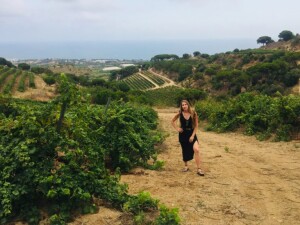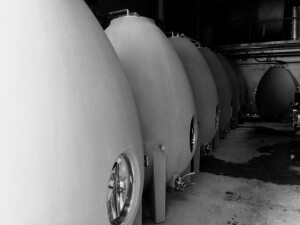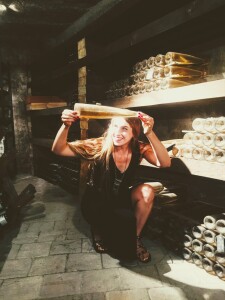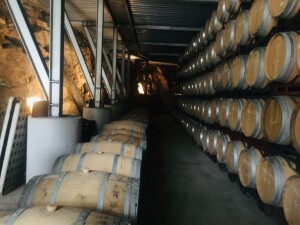Today we have a guest post from Caroline Abbott who is visiting Bodega Alta Alella Mirgin in the Catalonia’s Alella DO. Caroline wrote this piece following a 29-day trip around Spain during which she visited 17 wineries and traversed over 4,000 km (2,500miles) along Spain’s eastern coast. We thought it made for an excellent “travel daydream” in these difficult-to-travel times.
The Mediterranean’s blue-green waves glitter in the background, the sun shines brightly, threatened by impending charcoal clouds. The vineyards’ leaves and branches sway in the saline sea breeze, the vines are heavy with grape clusters ready to be picked at the harvest that has already begun.
I am at Bodega Alta Alella Mirgín, the closet winery to Barcelona situated on the Costa del Maresme, 20km from the city center. Nestled in the Parque Natural Serralada de Marina, the property actually stands in two towns, Alella and Tiana, and prides itself on its organic farming ethos and family-owned origins. Founded by the previous Technical Director of Sparkling for Martini & Rossi Josep María Pujol-Busquets Guilléns and his wife Cristina, it is now mostly now run by his daughters Mireia and Georgina, a biologist and nutritionist who dedicate themselves to the family trade with dedication and precision.
The visit is graciously given by Valérie Veilleux, the Brand Ambassador who is a whiz at all things marketing, communication, wine tourism, distributor management, languages (she speak 4 languages and oversees the translations for everything) – you name it! We had met at the Salón de Vinos Radicales in Madrid back in February (before all of our lives changed due to the wretched virus) and I was instantly hooked, spending more time at her table and taking copious notes than at any other. I promised to visit, and a mere six months later, here I was, with those same notes in hand, ready to link the impressive wines tasted to their origins.
A small, vivacious woman with a big grin, warm heart, and razor-sharp mind, she meets me at the entrance in a huge, dusty Cadillac and proceeds to drive me all around the vineyards, explaining every feature with extreme detail and gusto. I barely have to ask any questions, as an astonishing wealth of information pours forth regarding anything and everything related to the property and wines. Set in an amphitheatre-shaped area between 50 and 320 meters above sea level, their main varietals include Pansa Blanca, better known as the Cava star Xarel-lo, Pansa Rosada, a clone of Xarel-lo with little tannin and beautiful dusty-pink grapes, Chardonnay, Macabeo (Viura), Syrah, and Mataró (Catalán for Monastrell).
The soil is called sauló, a very fertile granitic sandy subsoil formed by a geological substrate of granites that, in certain environmental and hydrological conditions, decompose very easily, forming the soil characteristic of this area. Its high acidity, low limestone content, and good natural drainage create the perfect combination for the minerality and salinity expressed in the wines. I had never experienced vineyards such as these, with so much natural vegetation that varies significantly from parcel to parcel (aromatic herbs, edible flowers, bamboo, pine trees, and the rieras – sandy flooding zones at the lowest elevation with an almost tropical climate.
After the in-depth explanation of the terroir, she leads me to the winery, bustling with staff cleaning and shutting down after a long, hot day of harvesting and pressing. She leads me into a unique cellar with barrels and bottles for aging right across from a rock wall of the same granite on which we had just walked. I am pretty sure that was the most “natural” cellar I have ever seen! She explained what the fun contraptions in the winery were, such as milk machines for cryo-maceration, tiny tanks for micro-macerations, and several concrete eggs they have recently discovered as perfect for Pansa Rosada, as the concrete provides just the perfect amount of tannins and the natural bâtonnage brings out the complexity and mouthfeel so pleasing on the palate. They even had an artist manufacture some special amphorae made with a percentage of their sauló soil for that added “terroir factor”.
Our last stop before stopping in the shop to pick up some bottles to take with us was in the Cava Vella, the cellar with the prized last few bottles of previous vintages and the incredible Mirgin Exeo and Opus Cavas, aged entirely with a cork and with the rémuage and dégorgement scrupulously completed dry and by hand (without the usual freezing of the necks to remove the yeast). What a treat to see all of this in person!
A quick stop by the wine tourism center with a sleek kitchen and underground events space concluded the visit. We chose a Mirgin Opus Cava de Paraje Calificado and 2019 Tallarol, their no-sulfites-added rendition of Pansa Blanca, for drinks and tapas at the local vermutería with Gonzalo Garnacho, the Export Manager. She generously suggested I stock up on a few faves to take with me later, including the brand-new 2019 Asarvos amber wine experiment that was just calling my name and 2019 Cau d’En Genis, a top-seller with which I was not familiar.
Day transitioned into evening as we enjoyed one another’s company well past dark, forging friendships and relationships that are the beating heart of the wine world. Part of the reason I am visiting these wineries is to show these incredibly hard workers my love and appreciation, and to share their dedication and commitment to the ever-more-difficult world of wine in the midst of climate change and the global pandemic. They are superstars, and I am honored to have been offered a glimpse into their passionate endeavors.
Moltes gràcies per a tots vosaltres – salut!
About the author: Caroline Abbott, CSW, CSS, WSET 3 was born to American parents in Madrid and grew up there. As a teenager, she knew that the world of artisanal alcoholic beverages was her vocation. Before graduating with a BS in Entrepreneurship and Managements in 2011, she delved headfirst into the worlds of hospitality, brand ambassadorship, trade shows, and sales. These eventually led to a Market Manager position for a New England beverage brokerage firm.The final catalyst for deciding wine was her future was selling a global portfolio while studying for the CSW exam in 2015. After an organic winemaking stint in Hungary and globetrotting for 8 months, she landed in Melbourne, Australia. Working there with the top Spanish-wine importer inspired her to take the leap back to her native country. During another 5 months of travel, she launched her bilingual translations business, Vinotations. The long Covid quarantine was the impetus for her longtime dream to come true: traveling solo to visit 17 Spanish wineries in 29 days! This blog post was born from that odyssey. Currently, she loves being back home in Madrid, after 11 years away. In addition, she is Marketplace Success Manager in Spain for Vivino, the world’s most-downloaded wine app.
- This post was originally published on Caroline’s blog, Vinotations.
- Photo credits: Valérie Veilleux, Director of Communications at Alta Alella



